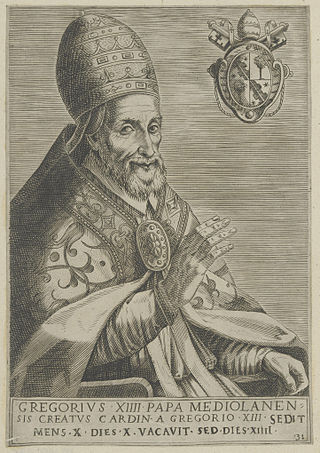
Alessandro Damasceni Peretti di Montalto was an Italian Catholic Cardinal Bishop. He received the title from his great-uncle Felice Piergentile after the latter was elected Pope Sixtus V on 24 April 1585, in the consistory on 13 May, and was installed as Cardinal Deacon of San Girolamo dei Croati on 14 June 1585; the cardinal was then fourteen years old. The Republic of Venice inscribed him in the Libro d'Oro as a patrician of Venice that same year. Though he was made the permanent governor of Fermo the following year, and was often the papal legate in Bologna, he was not made a bishop until 1620, when he became Cardinal-Bishop of Albano. He served also as Vice-Chancellor of the Holy Roman Church (1589–1623) and Cardinal Protector of the Kingdom of Poland and of the several religious orders.

The Basilica of St. Mary of the Angels and of the Martyrs is a Catholic titular minor basilica and former Carthusian conventual church in Rome, Italy, constructed in the ruined frigidarium and tepidarium of the Roman Baths of Diocletian in the Piazza della Repubblica.

The Pontifical Croatian College of St. Jerome is a Catholic college, church and a society in the city of Rome intended for the schooling of South Slav clerics. It is named after Saint Jerome. Since the founding of the modern college in 1901, it has schooled 311 clerics from all bishoprics of Croatia.

The Basilica of Saint Augustine in Camp Martius, commonly known as Basilica of Saint Augustine is a Catholic titular minor basilica in the Campus Martius area of Rome, Italy. Dedicated to Saint Augustine of Hippo it serves as the motherhouse of the Augustinian Friars.

Sant'Anastasia is a minor basilica and titular church for cardinal-priests in Rome, Italy owned by the Syro-Malabar Catholic Church.

San Martino ai Monti, officially known as Santi Silvestro e Martino ai Monti, is a minor basilica in Rome, Italy, in the Rione Monti neighbourhood. It is located near the edge of the Parco del Colle Oppio, near the corner of Via Equizia and Viale del Monte Oppio, about five to six blocks south of Santa Maria Maggiore.

The early Christian imperial basilica of the Saints Martyrs Vitale, Valeria, Gervasio and Protasio known more commonly as the basilica of San Vitale and Compagni Martiri in Fovea or more simply as San Vitale al Quirinale. It is the oldest Catholic place of worship in the historic center of Rome, located in via Nazionale. The imperial basilica of San Vitale al Quirinale, built under the pontificate of Pope Siricius after 386 and consecrated and richly decorated by Pope Innocent in 402 is the first public Christian basilica with a baptistery not founded on pre-existing pagan temples, mentioned in the Liber pontificalis, built by the Emperor Theodosius at the behest of Saint Ambrose of Milan, in honor of the miraculous discovery of the bodies of martyrs Gervasius and Protasius in Milan. It is the most frescoed basilica in Rome.

Sant'Eustachio is a Roman Catholic titular church and minor basilica in Rome, named for the martyr Saint Eustace. It is located on Via di Sant'Eustachio in the rione Sant'Eustachio, a block west of the Pantheon and via della Rotonda, and a block east of Sant'Ivo alla Sapienza and the Via della Dogana Vecchia.

The Basilica of Saints John and Paul on the Caelian Hill is an ancient basilica church in Rome, located on the Caelian Hill. It was originally built in 398.
Martino Longhi the Elder (1534–1591) was an Italian architect, the father of Onorio Longhi and the grandfather of Martino Longhi the Younger. He is also known as Martino Lunghi.
Marchese GerolamoTheodoli was an Italian nobleman and architect, best known for designing the Teatro Argentina in Rome.

The 1592 papal conclave elected Pope Clement VIII in succession to Pope Innocent IX.
Giovanni Fontana was a late-Mannerist architect, as well as brother of Domenico Fontana, and uncle of architect Carlo Maderno.

The Fontana dell'Acqua Felice, also called the Fountain of Moses, is a monumental fountain located in the Quirinale District of Rome, Italy. It marked the terminus of the Acqua Felice aqueduct restored by Pope Sixtus V. It was designed by Domenico Fontana and built in 1585–1588. It is located at the intersection of Largo Santa Susanna and Via Venti Settembre; across and diagonal from the Largo, is the church of Santa Susanna, while across Via Venti Settembre is the church of Santa Maria della Vittoria.

The Church of San Pellegrino in Vaticano is an ancient Roman Catholic oratory in the Vatican City, located on the Via dei Pellegrini. The church is dedicated to Saint Peregrine of Auxerre, a Roman priest appointed by Pope Sixtus II who had suffered martyrdom in Gaul in the third century. It is one of the oldest churches in the Vatican City.

The October to December 1590 papal conclave was the second conclave of 1590, and the one during which Gregory XIV was elected as the successor of Urban VII. This conclave was marked by unprecedented royal interference from Philip II of Spain.

The hospital of San Giacomo in Augusta, also known as San Giacomo degli Incurabili was a historic hospital located in Rome.

Santa Caterina da Siena is a church in Rome dedicated to Catherine of Siena. It is sited on via Giulia in the Regola district.

Pietro Gagliardi was an Italian painter and architect, who decorated many churches and palaces in Rome and throughout Italy.

The Cesi family is an Italian noble family which belonged to the high aristocracy of Rome and the Papal States.




















